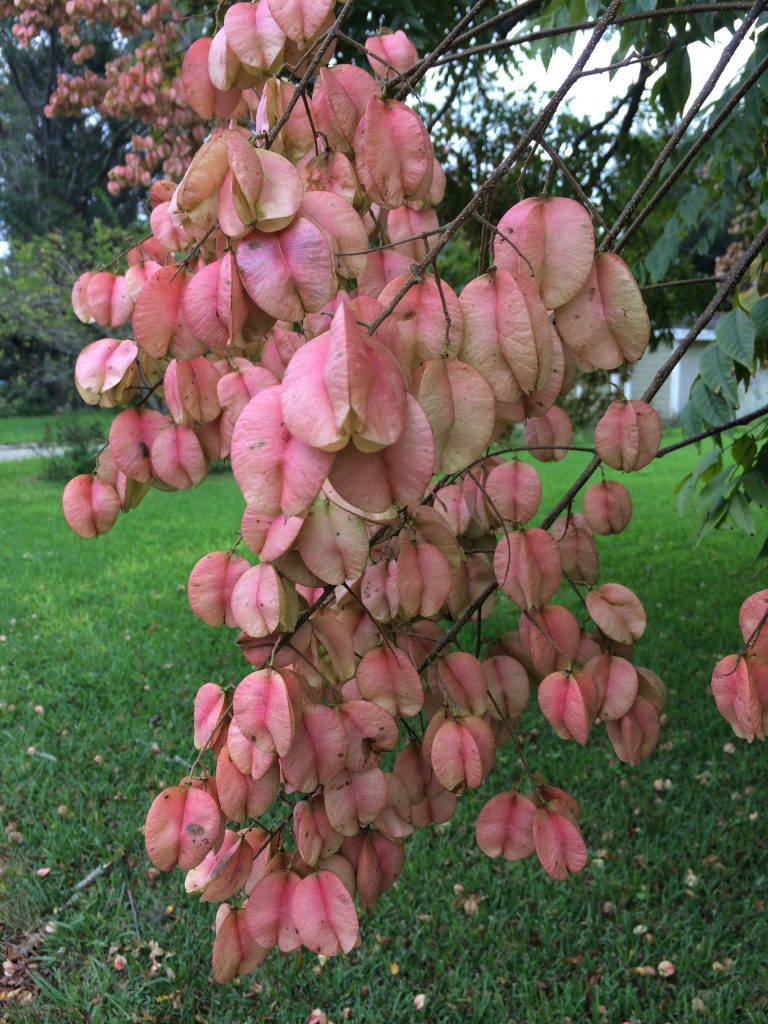
Easy to identify, difficult to remember, the Golden Rain Tree. Photo by Green Deane
Golden Rain trees are now fruiting and have seeds of debatable quality. Earlier in the year the trees had yellow blossoms that showered down. Now the pink pods are developing seeds containing eruic acid. (Currently most of the seeds are pale green or white and soft but they will turn black and hard.) If their flavor is acceptable I suspect they are a famine food — eaten sparingly — because of the eruic acid, which has a long history.
Eruic acid is the prime oil in Rape seed (a member of the mustard family.) Used as a cooking oil it was known for causing lung cancer in cooks in India. In rat studies the oil interfered with heart muscle metabolism. It was brought out of the gastronomical wilderness after cocoanut oil was demonized along with saturated fats by the infamous Ancel Keyes in the 1950s. The cooking oil industry turned to corn and soybean oil. When research showewed those started to generate disease, rape seed oil was chosen as the anointed one (meaning cheap to produce.) Plants were bred to reduce the Eruic acid (a polyunsaturated oil) creating Canola (Canada Oil Low acid.) Even the low-acid Canola oil has to go through much industrial processing before being bottled for use.
In short the oil that was reduced and removed to create Canola is found in Golden Rain tree seeds. Those who watch movies might recall it is also one of the ingredients in Lorenzo’s oil used to treat adrenoleukodystrophy (ALD). Where the seeds are reported eaten, they are roasted.
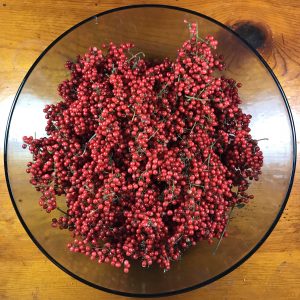
Brazilian Pepper Berries. Photo by Green Deane
Also beginning to fruit is the controversial Brazilian Pepper. At one time it was heavily promoted as the “Florida Holly” ignoring that the state has many native hollies. Its berries are often confused with a relative called Pink Peppercorns. In fact “Pink Peppercorns” were banned from the United States for several years because authorities thought they were the same species as Brazilian Pepper. As for using the Brazilian Pepper berries as spice, clearly some people can do so without any problems. Other people get extremely sick trying them just once. Some people can use them for a few days or weeks without a problem and then get ill. As I tell my students in foraging classes, you’re on your own with this one. So what am I going to to with them? Making one test gallon of wine, and, to flavor a two gallons of mead (as they make a nice honey.)
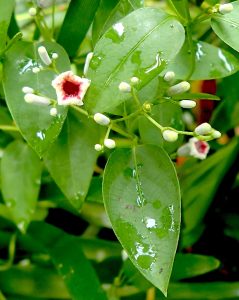
Skunk Vine lives up to its name. Photo by Green Deane
Perhaps as a last gasp — virtually — some Skunk Vine was blossoming this past week (along with some Black Cherries.) Skunk Vine is aptly named though its aroma drifts more towards bathroom than skunk. However the tough vine is something of a nutritional powerhouse with some of the good chemicals one finds in the Brassica family. You can eat it raw but if you cook it outside is recommended. It was intentionally introduced in Florida to make rope. This was done just before 1900 when a lot of ships were still carrying sails and five miles of rope. Ground zero was the USDA Brooksville Field Station in Hernando County Fl. Yes, this invasive vine — like many other species — was imported by the United States Department of Agriculture. Thirty-six years later it was all over Florida but it took until 1977 for it to be a recognized invasive (long after it had crawled into other southern states.) While the blossoms are attractive we eat only the leaves and young tips. You can read about Skunk Vine here.
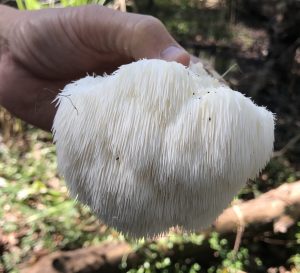
Lion’s Mane is tasty and medicinal. Photo by Green Deane
We are shifting mushrooms seasons from terrestrial to trees or ground to wood. Instead of looking down we now look up. Milk caps and chanterelles are giving way to Oysters, Lion’s Mane and Chicken of the Woods. Edible fungi that like wood also often like cooler weather but not exclusively. There are oysters and chickens other times of the year but cool is prime time. Lion’s Mane, however, is one I see only after the season starts to turn cooler and only down to northern Florida. It’s a choice find. To my pallet raised on the coast of Maine it tastes like carb or lobster and I use it in similar ways. This particular specimen was found in Jacksonville. You can read more about it here.
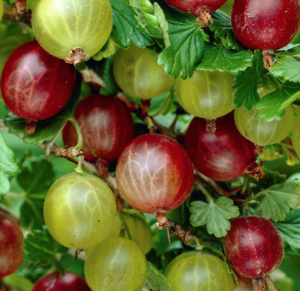
Gooseberries and currants come in several colors and flavors.
You won’t find wild Gooseberries or currants anywhere near The South. They like cool, humid weather: Think New England, Nova Scotia, Newfoundland, New Brunswick and west of there (and also possibly the tops of the Appalachian Mountain Chain.) There were several “blights” in the last century. One took out the American Elm and another the great Chestnut. A third took its toll on Gooseberries. They did not get the disease themselves, the White Pine Blister, but they were the intermediate host of the disease. As one might imagine a pine blister in the the Pine Tree State was serious business thus Gooseberries and currants had to go. Legions of Boy Scouts and WPA workers destroyed it where they found it. But, I do remember seeing them in the wild. We often rode horseback over abandoned woods roads where there were also abandoned farm houses. There I saw Gooseberries and currants self-seeding. A ban on the plants was federally imposted in 1911 then shifted to the states in 1966. You can harvest Gooseberries now here and there at picking farms and no doubt there are some wild one still. You can read about Gooseberries here.

Foraging classes are held rain, shine, hot or cold. Photo by Nermina Krenata
Foraging Classes: We may have to dodge November hurricanes but it is a good time of year to forage.
Nov 4th Eagle Park Lake, 1800 Keene Road, Largo, FL 33771. 9 a.m. Meet at the pavilion near the Dog Park
Nov. 5th Red Bug Slough , Sarasota. 9 a.m. Because of renovations, we have to meet at a different location at Red Bug Slough in Sarasoata. Normally it is at 5200 S. Beneva Road. Instead we will have to park at Gypsy Street and South Lockwood Ridge Road. Gypsy can be reached by Camphor Ave which runs south of Proctor west of Beneva.
Nov 11th Mead Garden: 1500 S. Denning Dr., Winter Park, FL 32789. Meet at the bathrooms, 9 a.m.
Nov 12th, Bayshore Live Oak Park, Bayshore Drive. Port Charlotte. Meet at the parking lot at Ganyard and Bayshore, 9 a.m.
To read more about the classes, to pre-pay or sign up, go here.

You get the USB, not the key.
150-video USB would be a good end of spring present and is now $99. My nine-DVD set of 135 videos has been phased out. The USB videos are the same videos I have on You Tube. Some people like to have their own copy. The USB videos have to be copied to your computer to play. If you want to order the USB go to the DVD/USB order button on the top right of this page. That will take you to an order form. I’d like to thank all of you who ordered the DVD set over the years which required me to burn over 5,000 DVDs individually.

Green Deane Forum
Want to identify a plant? Perhaps you’re looking for a foraging reference? You might have a UFO, an Unidentified Flowering Object, you want identified. On the Green Deane Forum we — including Green Deane and others from around the world — chat about foraging all year. And it’s not just about warm-weather plants or just North American flora. Many nations share common weeds so there’s a lot to talk. There’s also more than weeds. The reference section has information for foraging around the world. There are also articles on food preservation, and forgotten skills from making bows to fermenting food.
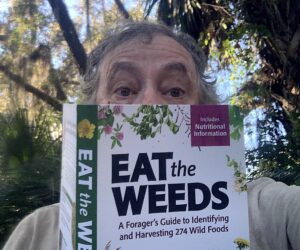
Finally, a physical copy of the book.
Now in print is EatTheWeeds, the book. It has 274 plants, 367 pages, index, nutrition charts and color photos. Several hundred have been pre-ordered on Amazon. Most of the entries include a nutritional profile. Officially it will be published December 13th (to suit the publisher publicity demands) and apparently to appeal to the winter market.
This is weekly newsletter #578. If you want to subscribe to this free newsletter you can find the sign-up form in the menu at the top of the page.

